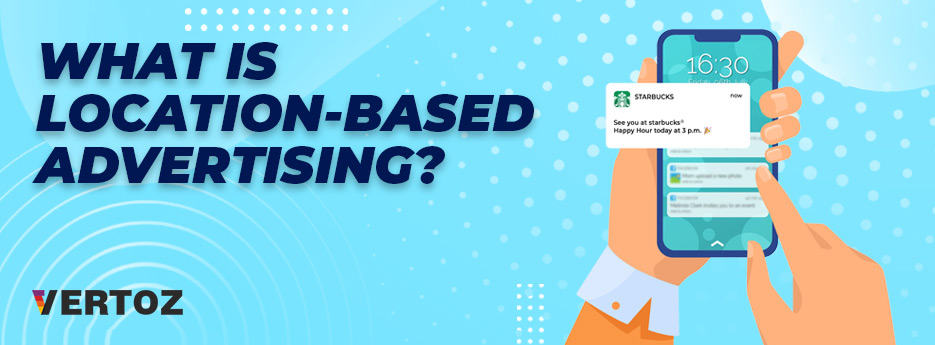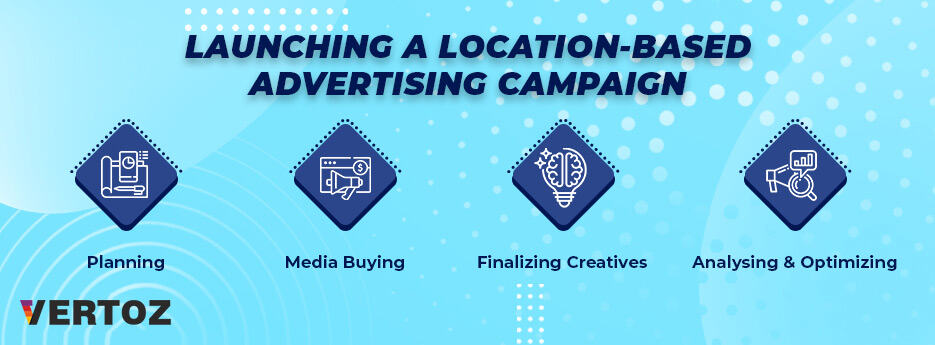
Location-based advertising, simply put, is a technology that lets mobile ads cut through the clutter and stand out from the crowd of advertisements. It lets you send marketing messages to the audience when they’re in a specific geographical radius.
Small to medium sized businesses have increasingly leveraged the power of location-based advertising to increase foot-fall at their physical stores by advertising the products to the audience who can easily find those in the stores.
It is anticipated that by 2022, $38.67 will be spent alone on location-targeted advertising (1). According to a 2019 report by Factual, 9 in 10 marketers confirmed that location-based advertising results in increased sales and about 84% surge in customer engagement (2).
How Does Location-Based Advertising Work?

Location-based advertising usually combines mobile technology with location data to understand consumer’s patterns within a particular geographic area over time. It takes the help of location-identifying signals like IDs, WiFi, cell towers, GPS, etc.
This lets marketers design messages on the basis of weather, retail locations, the behaviour of local customers, etc. However, location-based marketing works in a fashion that is fuelled by the permission of customers, meaning, for these messages to be sent out to the customers, it must be accepted by them.
At its core, location-based advertising is all about relevance. If a customer has come to watch a movie in a theatre, he or she might receive a message about a restaurant which could be a few blocks away with ‘get directions’ option placed in an ad. Thus, it is basically a customized and minutely targeted form of digital marketing.
Types Of Location-Based Advertising

1. Geo-targeting
Geo-targeting or geo-aware targeting relies on real-time location data offered by mobile service providers. Geo-targeting can be considered one of the original forms of location-based targeting which has existed nearly from the early 2010s.
This type of targeting usually works best for broad categories like state, city, town, etc. For example, sending marketing messages to anyone who has just entered the province of the town, state or a city by attracting them to try their products or services.
2. Hyper-contextual Targeting
This type of targeting is specific to a particular geographical area and is used to send out hyper-contextual messages that would be significant to a particular target group. These messages are meant to be sent out to a specific audience at a specific time of the day.
Although this type of messaging is usually sent out to drive purchase intent and increase sales, it can also be used to make people aware of something within a particular geographical area.
3. Geo-fencing
As the name suggests, this type of targeting is used to create a ‘fence’ around a particular geographic area on the basis of longitude and latitude. The main motive is to get people in a particular area to visit your store and increase the foot traffic.
Geo-fencing makes the use of GPS and RFID to function and thereby deliver personalised experiences to the consumers. It is usually designed with great offers and rich creatives to drive the purchase intent of your consumers.
Example of this could be sending time-specific offers to consumers in that radius. Geo-fencing is expected to grow 27% by 2022, owing to its technological advancements, as per MarketsandMarkets (3).
4. Geo Conquesting
Geo conquesting is a relatively new marketing trick which is used to target the prospects around the competitor’s store and attract them to your store. Once you’re able to minutely understand the consumer behaviour, this strategy works wonders.
Once you’re able to find consumers who are already interested in a product, enticing them with attractive offers to get them to buy from you becomes easier. It increases engagement and conversion rates significantly.
Sectors like restaurants, clothing brands, telecommunication and financial services, etc use this technique to attract competitor’s customers. The key is to understand consumer behaviour and target them with engaging and impactful ads.
5. Beacon
Beacon technology is another facet of location-based advertising. Also known as proximity marketing, beacon marketing works in a similar fashion as geofencing. It operates with the help of Bluetooth technology to transfer information to nearly placed mobile devices.
Marketers can use this type of targeting to send timely and targeted messages to consumers present in a specific geographical location. Beacons can be placed anywhere to reach the nearest prospects at any time since they are tiny and flexible.
Benefits of Location-based Advertising

1. Highly Personalized
Location-based advertising is a personalized form of communication since it only targets the selected prospects within a specific geographical area and in the real-time. Rich media creatives are made keeping the consumer behaviour in mind which increases the chances of better engagement and conversion.
2. Minutely Targeted
There is a massive use of ad-blockers nowadays due to irrelevant ads getting popped up on our devices. Location-based advertising uses detailed targeting, reducing the chances of losing relevance. Localizing the ads enables marketers to target specific people in a particular radius with which they can relate to.
3. Greater Suitability
Location-based advertising is suitable for small, mid as well as large-sized business corporations. LBA enables reaching out to the local customers in a precise location resulting in better relevance. It helps to resonate effectively with the prospects as they’d be relatively more interested in the offers that address their concerns.
4. Delivers Holistic Experience
Location-based advertising is quite adaptable and flexible which lets marketers make the most out of multiple channels and platforms. It can be merged with a well-planned omnichannel marketing strategy to deliver a holistic experience to the prospects and maximise the penetration of your campaign.
Launching A Location-based Advertising Campaign

1. Planning
Planning is the first step to launching your campaign. Researching plays an important role in deciding the framework for your campaign. Before getting started with your LBA campaign, it’s of utmost significance to decide the following:
– Your Goals
What are you trying to achieve from this campaign? Is it creating more brand awareness, boosting sales, driving traffic to the web page, increasing foot traffic to the store, promoting a specific offer, etc. Being clear with your objective helps you with a clear direction of your campaign, so it’s crucial to get it clear at the very beginning.
– Your Target Audience
Deciding the audience you’re going to serve ensures the efficacy of your campaign. Without having a clear understanding of your target audience, you wouldn’t know how to communicate, what to communicate, how to present, how to deliver, etc. Understand who your TG is, what do they like, dislike, what’re their pain points, etc.
– Metrics
Another thing that you would want to ensure before going about launching your LBA campaign is setting up metrics to evaluate the success of your campaign like clicks, impression, reach, cost per click, traffic volume, etc. Secondly, make sure your campaign is customer-centric and that your consumers are benefitting from the way you’re delivering your campaign.
2. Media Buying
Now that you’re done with optimal planning and dotting a clear path for your campaign, it’s time to buy ad space where you’ll display your ad creatives. This will be in accordance with your target audience – where they spend most of their time at, what do they engage with the most, etc.
Media buying is a process of buying ad space and this can be done with the help of self-serve demand-side platforms. You can operate this yourself or take the help of an ad agency or managed services against which you’ll be charged a minimum ad spending per campaign.
Suggested Read: What Is a Demand-side Platform & How Does It Work?
3. Creatives
After buying ad space, now let’s get to the best practices for making creatives. Ensure that your creatives are in line with your target audience. Certain elements that must be clearly visible in your creatives are a call to action, coupons that can be redeemed easily, directions to your store if applicable.
Creatives should be optimized as per each user. This is one of the features that is often included in the media buying package. Other than that, make sure that you’re practising A/B testing to understand which of your creatives are working well with your audience and then optimize others as per that.
4. Analysing & Optimizing
Now that you’re done with everything, one important step is to keep analysing your campaign to track the performance. Don’t let the campaign run by itself, take charge and operate it well. When you keep an eye on metrics, you get better insights as to what is working well with your audience and vice versa.
You can then optimize the aspects that are lacking in performance at an initial stage. By doing this, you also tend to make the best use of the allocated budget. It’s important to get clear with your tracking mechanism and setting the metrics beforehand.
Final Note: The advertising world is dynamic and versatile. In order to get the best out of this fast-paced technology, it’s important to keep yourself updated about the new trends and insights. Location-based advertising is a new gimmick in the advertising world and is working well for businesses.
It hasn’t just helped them get better foot traffic to their physical stores but also enhance the engagement with their customers leading to a strong relationship with them. Having said that, to yield maximum results out of it, it’s important that the execution is up to the mark.
We recommend that you discuss your location-based advertising strategy with your agency in a detailed manner and set your expectations clear. However, you can also opt-in for a do-it-yourself or a demo of the platform by writing to us at mktg@vertoz.com.

